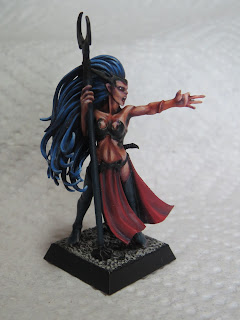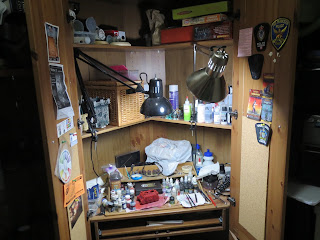Well, there's two reasons for this. One, I've got some fresh pics of some recently (and not-so-recently) completed models. However, I'm no professional photographer, and other than a really brief intro course to Photoshop that I took about a decade ago, I don't know much about editing pics for online publication. So, what I've done is take some pics with my wife's Nikon D60 SLR, and have sent them to a buddy of mine who is a semi-pro photographer (I say "semi-pro", as he still needs his other job to pay the rent). Once I get the pics back, I'll post them up here, along with his email address if you need any similar work done. Not to worry, he's not going to town on them (ie, he's not "cheating" the pics much like the editors at Maxim and Playboy like to do with their models), he's just trying to get the colours to be true to the actual models.
Below is a quick pic of my photo booth setup. It's a portable setup I got at Staples years and years ago, and it does a decent job, although I think there are better setups out there now:
The booth is set up inside my painting cabinet. That means all painting comes to a stop while I'm taking pics... it's a pain in the butt, and part of the reason why I haven't done any step-by-step painting tutorials yet. It's just such a hassle to clear a space, set up the booth, set up the camera and tripod, and then reset my painting station once the pics are done.
The reason I set it up in there is that I've found that my painting lamps work pretty well for photo purposes. I've got two of your standard desk lamps in there, with halogen daylight bulbs installed (they give off a nice "white" light, rather than the yellow-ish light from most bulbs). The top light gets diffused nicely through the ceiling of the booth, while I use parchment paper on the front lamp to diffuse the light there.
While a SLR camera is not necessarily a must (I've taken great pics with my tiny Canon Elph, after playing around with the white-balance settings), the tripod is essential. Put the camera on a 2-5 second delay, hit the button, and you will get blur-free shots every time. With such a tiny subject, not even the best anti-vibration mechanism will be able to compensate for hand shake.
The second reason for not having any new pics of my works up is that I have project ADD (Attention Deficit Disorder). I keep starting projects, then lose steam and focus, only to get all fired up about a brand new project. Thus, I almost never manage to actually FINISH anything. Here's a bunch of WIP (Work In Progress) shots of projects that have been abandoned like illegitimate children at a Catholic orphanage:
These Dark Eldar Mandrakes are only two of 5 models I started up for my army. I reasoned that this would be a quick project that I could complete in only a session or two, thus building momentum and enthusiasm for the rest of the army. Suffice to say, I got as far as cleaning the models, prepping them, giving them a black undercoat, with a light spritz of white primer from above to help me visualize the shadows and highlights. I've got TONS of models that have only reached this stage...
This is a tower from the ancient "Battlemasters" boardgame (really old vets will recognize this guy). I think it was a game designed by Games Workshop way back in the day, but licensed and produced by Milton Bradley (I could be wrong though). I knew plenty of people who bought the box set just to get tons of cheap Empire and Chaos models, as well as this fantastic piece of terrain. I managed to pick this tower up from a second hand sales table at a local convention for $8. It was much much better than it had any right to be... considering it came from a toy company with lower standards than any gaming company would have had. It went together very well, it seems nice and robust, and is sitting on my projects shelf with several shades of black to white. This was my first terrain piece that I attempted with my airbrush... still not sure what I think of it though. The near side presented in the photo was given a quick wash of black ink, after I had sprayed a coat of Purity Seal varnish all over the model. The varnish was to make the surface a bit slicker, in the hopes that the ink would settle in the cracks and crevasses of the model better. It wasn't exactly a wondrous success, which led to me shelving the project (for the meantime).
This is another component of my half-heartedly started Dark Eldar army. I gave these guys / girls a basecoat applied by airbrush, a quick spritz from above with a slightly lighter tone for a hint of a highlight. The two models to the left had their armour highlights finished off, while the other two are still waiting for some more work. The flesh loinclothes were painted up with a recipe of colours taken from the 'Eavy Metal Masterclass book (the purple shading glaze was quite the revelation to me, coming out much better than I had expected), and the rest of the models were finished up in colours that seemed worth trying out at the time. Not so sure about that now... likely I'll redo the guns in completely different colours. I also started painting the exposed face on the left-most model (basecoat and ink wash only so far), but I'm not liking where it's going... I'm probably going to redo it in much lighter colours... eventually.
This was a Dark Elf Sorceress model I started working on for my Fantasy Dark Elf army. Again, this army is barely any further along than my Dark Eldar army. It wasn't until I started painting this model that I realized that somewhere along the way, one of her fingers had broken off. With a resigned sigh, I decided to carry on painting her anyway. The skin is turning out a bit too warm for me (like she's spent a few weeks in Mexico), and the red that I used for a basecoat seems a bit too earthy in tone. A few more highlights might fix this, and then I can go on to finishing the rest of her clothing, staff, and base. One day...
An old Rackham Tir Na Bor dwarf that I started about 6-7 years ago, and has been languishing ever since. I can't even bear to go back to this one... I don't even paint flesh the same way any more... I would probably either finish it off with a quickie paintjob, or redo the whole thing from the beginning. Sigh.
Another Tir Na Bor dwarf. Some preliminary shading going on. I abandoned this project just after abandoning the other dwarf, only to go back to it about a year ago. What I was trying to do was see if Matthieu Fontaine's contrasted metallics techniques would work on this kind of model. If you compare the sword blade from the front (basecoat only) to the shot from the back (shaded with pure matt black and highlighted with the lightest metallic paint I had at the time), you can see the massive amount of contrast and implied shine that his technique had. I was very impressed. After proving to myself that it worked, I move on to other projects... perhaps one day this guy will get the finishing paintjob that he deserves...
Tabletop quality (non competition) models painted for my Sisters of Battle army (which has somehow won more than a few "Best Painted Army" awards). Not bad, and oh so close to being finished. The banner really intimidates me... friends of mine have come to expect some neat freehand stuff from time to time, and I can't muster up the courage to do something crazy here. I think I'll need a major kick in the butt to get this done...
Sisters of Battle Rhino / Immolator Armour Personnel Carrier. Airbrush basecoat, a little hint of airbrushed highlights, and then the start of some brushed in shading. In order to achieve a vibrant contrast with the shades, I started with a dark blue instead of black, and only used black for the absolutely deepest recesses. This is stupidly time consuming work, and since I have project ADD...
Sister of Battle Cannoness. The leader of my army, so I needed to take my time with her. Shading done like the APC above. Metallics done like the dwarf above. Sword blade was done with an airbrush, and finished off with painstaking brushwork. I will probably have to rework the pistol to incorporate some green in there somehow, otherwise the bright sword unbalances the composition somewhat. Green on the base will help too. I should repaint the fur collar to a dark brown, otherwise the white hair gets a bit lost. Banner needs completion... it's just roughed in, and needs some serious time to polish it up. Again, it's time consuming work, and at this point I was really getting bored of working on her, so...
Anyway, lots of projects on the go. Hopefully I can finish something someday, but I thought I'd take a few quick pics with my Canon Elph to show you all. The most likely scenario is that some painting competition will come along, and that will motivate me enough to pick a project and finish it. And while some of these models look like they're coming along pretty well, if I need to get them competition ready, I'm going to have to take some more pics, blow them up to the point where I can see every little mistake, and rework entire areas. Keep in mind that most of the actual models are just over an inch in height... blowing them up to the size of your monitor is likely doing the paintjob no favours whatsoever.
Please comment and ask any questions you like. I'll try my best to answer them. Suggestions would be welcome as well.
And the real reason I can't get any models photo-ready / finished:


















